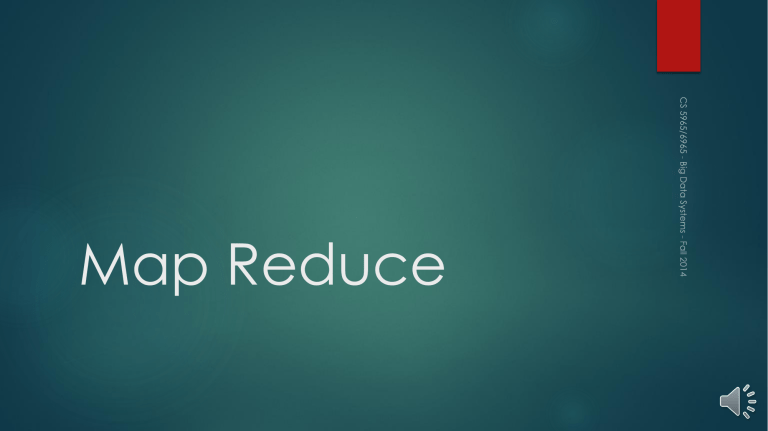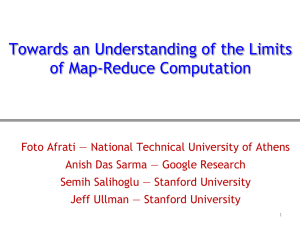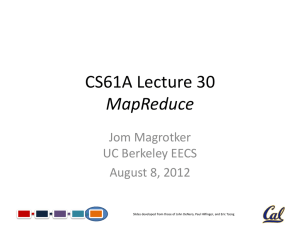Map Reduce
advertisement

Map Reduce
Last Time …
MPI I/O
Randomized Algorithms
Parallel 𝑘-Select
Graph coloring
Assignment 2
Questions ?
Today …
Map Reduce
Overview
Matrix multiplication
Complexity theory
MapReduce programming
interface
Two‐stage data processing
Data can be divided into many chunks
A map task processes input data & generates local results for one or a
few chunks
A reduce task aggregates & merges local results from multiple map
tasks
Data is always represented as a set of key‐value pairs
Key helps grouping for the reduce tasks
Though key is not always needed (for some applications, or for the input
data), a consistent data represent eases the programming interface
Motivation & design principles
Fault tolerance
Loss of a single node or an entire rack
Redundant file storage
Files can be enormous
Files are rarely updated
Read data, perform calculations
Append rather than modify
Dominated by communication costs and I/O
Computation is cheap compared with data access
Dominated by input size
Example
Count the occurrences of individual words in bunch of web pages
Map task: find words in one or a few files
Input: <key = page url, value = page content>
Output: <key = word, value = word count>
Reduce task: compute total word counts across multiple files
Input/output: <key = word, value = word count>
Dependency in MapReduce
Map tasks are independent from each other, can all run in parallel
A map task must finish before the reduce task that processes its
result
In many cases, reduce tasks are commutative
Acyclic graph model
Implementations
Original mapreduce implementation at Google
Not publicly available
C/C++
Hadoop
Open Source Implementation – Yahoo!, Apache
Java
Phoenix++
Open Source – Stanford
C++ - Shared memory
Applications that don’t fit
MapReduce supports limited semantics
The key success of MapReduce depends on the assumption that the
dominant part of data processing can be divided into a large number
of independent tasks
What applications don’t fit this?
Those with complex dependencies – Gaussian elimination, k-means
clustering, iterative methods, n-body problems, graph problems, …
MapReduce
Map: chunks from DFS (key, value)
User code to determine (𝑘, 𝑣) from chunks (files/data)
Sort: (𝑘, 𝑣) from each map task are collected by a master controller
and sorted by key and divided among the reduce tasks
Reduce: work on one key at a time and combine all the values
associated with that key
Manner of combination is determined by user code
MapReduce – word counting
Input set of documents
Map:
reads a document and breaks it into a sequence of words
𝑤1 , 𝑤2 , … , 𝑤𝑛
Generates (𝑘, 𝑣) pairs,
𝑤1 , 1 , 𝑤2 , 1 , … , (𝑤𝑛 , 1)
System:
group all 𝑘, 𝑣 by key
Given 𝑟 reduce tasks, assign keys to reduce tasks using a hash function
Reduce:
Combine the values associated with a given key
Add up all the values associated with the word total count for that word
Parallelism
Reducers
Reduce Tasks
Compute nodes
Skew (load imbalance)
Easy to implement
Hard to get performance
Node failures
Master node fails
Node with Map worker fails
Restart mapreduce job
Redo all map tasks assigned to this worker
Set this worker as idle
Inform reduce tasks about change of input location
Node with Reduce worker fails
Set the worker as idle
Matrix-vector multiplication
𝑛 × 𝑛 matrix 𝑀 with entries 𝑚𝑖𝑗
Vector 𝒗 of length 𝑛 with values 𝑣𝑗
We wish to compute
𝑛
𝑥𝑖 =
𝑚𝑖𝑗 𝑣𝑗
𝑗=1
If 𝒗 can fit in memory
Map: generate (𝑖, 𝑚𝑖𝑗 𝑣𝑗 )
Reduce: sum all values of 𝑖 to produce (𝑖, 𝑥𝑖 )
If 𝒗 is too large to fit in memory? Stripes? Blocks?
What if we need to do this iteratively?
Matrix-Matrix Multiplication
𝑃 = 𝑀𝑁 𝑝𝑖𝑘 =
2 mapreduce operations
𝑗 𝑚𝑖𝑗 𝑛𝑗𝑘
Map 1: produce 𝑘, 𝑣 , 𝑗, 𝑀, 𝑖, 𝑚𝑖𝑗
and 𝑗, 𝑁, 𝑘, 𝑛𝑗𝑘
Reduce 1: for each 𝑗 𝑖, 𝑘, 𝑚𝑖𝑗 , 𝑛𝑗𝑘
Map 2: identity
Reduce 2: sum all values associated with key 𝑖, 𝑘
Matrix-Matrix multiplication
In one mapreduce step
Map:
generate 𝑘, 𝑣
𝑖, 𝑘 , 𝑀, 𝑗, 𝑚𝑖𝑗
&
𝑖, 𝑘 , 𝑁, 𝑗, 𝑛𝑗𝑘
Reduce:
each key (𝑖, 𝑘) will have values
Sort all values by 𝑗
Extract 𝑚𝑖𝑗 & 𝑛𝑗𝑘 and multiply, accumulate the sum
𝑖, 𝑘 , 𝑀, 𝑗, 𝑚𝑖𝑗
&
𝑖, 𝑘 , 𝑁, 𝑗, 𝑛𝑗𝑘
∀𝑗
Complexity Theory for mapreduce
Communication cost
Communication cost of a task is the size of the input to the task
We do not consider the amount of time it takes each task to
execute when estimating the running time of an algorithm
The algorithm output is rarely large compared with the input or the
intermediate data produced by the algorithm
Reducer size & Replication rate
Reducer size 𝑞
Upper bound on the number of values that are allowed to appear in
the list associated with a single key
By making the reducer size small, we can force there to be many reducers
By choosing a small 𝑞 we can perform the computation associated with a
single reducer entirely in the main memory of the compute node
High parallelism low wall-clock time
Low synchronization (Comm/IO) low wall clock time
Replication rate (𝑟)
number of (𝑘, 𝑣) pairs produced by all the Map tasks on all the inputs,
divided by the number of inputs
𝑟 is the average communication from Map tasks to Reduce tasks
Example: one-pass matrix mult
Assume matrices are 𝑛 × 𝑛
𝑟 – replication rate
Each element 𝑚𝑖𝑗 produces 𝑛 keys
Similarly each 𝑛𝑗𝑘 produces 𝑛 keys
Each input produces exactly 𝑛 keys load balance
𝑞 – reducer size
Each key has 𝑛 values from 𝑀 and 𝑛 values from 𝑁
2𝑛
Example: two-pass matrix mult
Assume matrices are 𝑛 × 𝑛
𝑟 – replication rate
Each element 𝑚𝑖𝑗 produces 1 key
Similarly each 𝑛𝑗𝑘 produces 1 key
Each input produces exactly 1 key (2nd pass)
𝑞 – reducer size
Each key has 𝑛 values from 𝑀 and 𝑛 values from 𝑁
2𝑛 (1st pass), 𝑛 (2nd pass)
Real world example: Similarity Joins
Given a large set of elements 𝑋 and a similarity measure 𝑠(𝑥, 𝑦)
Output: pairs whose similarity exceeds a given threshold 𝑡
Example: given a database of 106 images of size 1MB each, find
pairs of images that are similar
Input: (𝑖, 𝑃𝑖 ), where 𝑖 is an ID for the picture and 𝑃𝑖 is the image
Output: 𝑃𝑖 , 𝑃𝑗 or simply 𝑖, 𝑗 for those pairs where 𝑠 𝑃𝑖 , 𝑃𝑗 > 𝑡
Approach 1
Map: generate (𝑘, 𝑣)
𝑖, 𝑗 , 𝑃𝑖 , 𝑃𝑗
Reduce:
Apply similarity function to each value (image pair)
Output pair if similarity above threshold 𝑡
Reducer size – 𝑞 2 (2MB)
Replication rate – 𝑟 106 − 1
Total communication from mapreduce tasks?
106 × 106 × 106 bytes 1018 bytes 1 Exabyte (kB MB GB TB PB EB)
Communicate over GigE 1010 sec 300 years
Approach 2: group images
106
𝑔
Group images into 𝑔 groups with
Map: Take input element 𝑖, 𝑃𝑖 and generate
images each
𝑔 − 1 keys 𝑢, 𝑣 | 𝑃𝑖 ∈ 𝒢 𝑢 , 𝑣 ∈ {1, … , 𝑔} ∖ {𝑢}
Associated value is (𝑖, 𝑃𝑖 )
Reduce: consider key (𝑢, 𝑣)
106
𝑔
Associated list will have 2 ×
Take each 𝑖, 𝑃𝑖 and 𝑗, 𝑃𝑗 where 𝑖, 𝑗 belong to different groups and
compute 𝑠 𝑃𝑖 , 𝑃𝑗
Compare pictures belonging to the same group
elements 𝑗, 𝑃𝑗
heuristic for who does this, say reducer for key 𝑢, 𝑢 + 1
Approach 2: group images
Replication rate: 𝑟 = 𝑔 − 1
Reducer size: 𝑞 = 2 × 106 /𝑔
Input size: 2 × 1012 /𝑔 bytes
Say 𝑔 = 1000,
Input is 2GB
Total communication: 106 × 999 × 106 = 1015 bytes 1 petabyte






